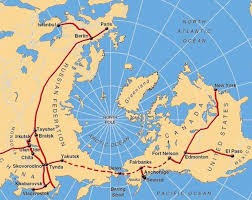Aug. 11—Chinese rail engineers have given thought since at least 2014 to the construction requirements for the Bering Strait tunnel required to build a “China-Russia-Alaska-Canada-U.S. high-speed railroad.” In May of that year, one of China’s most famous tunnel and rail engineers, Wang Mengshu, outlined China’s overall ambitious plans for building transcontinental high-speed railroads globally in an interview with Beijing Times.
The fourth of the transcontinental trunklines he identified caught international attention: the idea of linking Eurasia to Canada and the United States. Wang reported that planning was beginning on an estimated 13,000 km route, “starting from the northeast and heading north, through Siberia to the Bering Strait, crossing the Pacific Ocean by building a tunnel to Alaska, then going from Alaska to Canada, and finally to the United States.” He estimated that crossing the Bering Strait would require approximately 200 km of tunnels, “a technology used in the high-speed rail tunnel from Fujian to Taiwan, and the necessary technology is already in place.”
“If it is completed, people from China to the United States will no longer need to take a plane. They can take the high-speed rail to see the scenery of many countries along the way. According to the design speed of 350 km per hour, passengers can reach the United States in less than two days by high-speed rail,” he told Beijing Times.
Hearing of Wang’s interview, U.S. rail expert Hal Cooper, a champion for the Bering Strait tunnel for decades together with the Schiller Institute, told Russia’s RIA Novosti that while the political obstacles to Chinese, Russian, American cooperation may remain, “after this announcement by the Chinese, [the project] will never be suppressed. It’s never going to be swept back under the rug again.”
Seven months later, Wang told the New York Times in a December 18 interview, that the Bering Strait crossing "is a wish and a dream of not only China’s railway experts but also railway engineers in Russia, Canada and the U.S. whom I have spoken to. The technology developments in recent years in high-speed railway and underwater tunnels make it possible. It is a dream, but one that is within reach.
“The Chinese central government is not seriously considering it, not yet,” he reported. “But why not? We have the technology, and it is a good thing to do. It would benefit generations to come, and the environment. As railway engineers, we think it would be a great legacy to leave for future generations. It would connect continents. It would be a grand structure of human engineering.”
The New York Times wanted to know what the chances are that this grand idea would ever be built. Wang answered:
“That depends entirely on politics, because we have the technology. It depends on whether governments of the four countries can work together, make this dream come true and leave this amazing legacy for our children…. Some governments like to spend their resources on fighting wars. I think building a railway is far more meaningful than fighting wars.”




